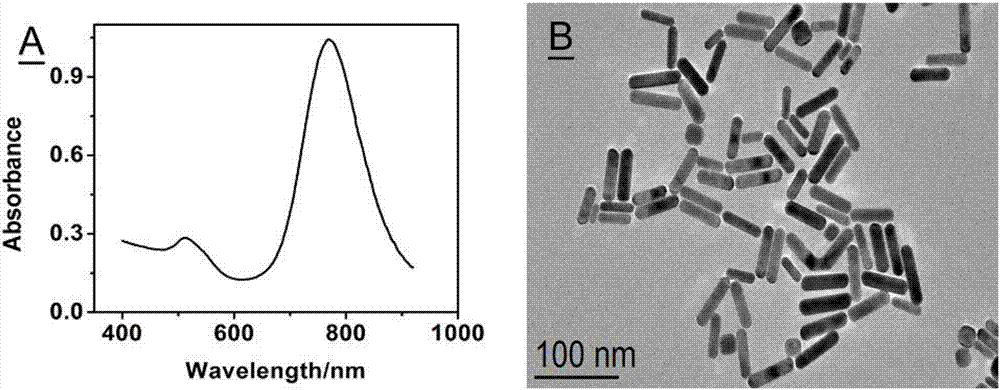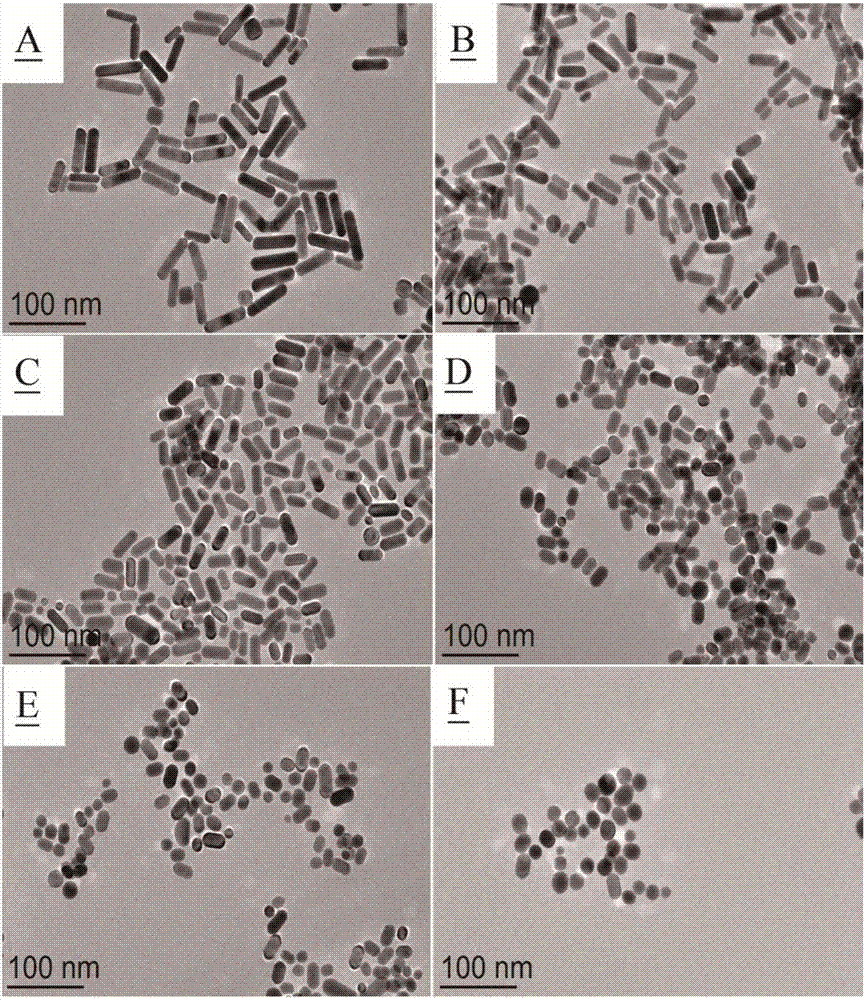Analysis method for organic phosphorus pesticide open hole visualized semi-quantitative detection
A technology for semi-quantitative detection of organophosphorus pesticides, applied in the field of quick test cards, can solve the problem of high cost and achieve the effects of low cost, good stability and good selectivity
- Summary
- Abstract
- Description
- Claims
- Application Information
AI Technical Summary
Problems solved by technology
Method used
Image
Examples
Embodiment 1
[0039] Synthesis of colorimetric reagent AuNRs and preparation of quick test card:
[0040] (1) The synthetic operation of AuNRs can be divided into two steps: the synthesis of gold species and the growth of gold nanorods.
[0041] (a) Synthesis of gold species: 250 μL of 0.01M HAuCl 4 ·3H 2 O was mixed with 9.75 mL of CTAB at a concentration of 0.1 M and 600 μL of freshly prepared NaBH was added 4 Solution (0.01M), after mixing uniformly for full reaction, place the obtained solution at 30° C. for 30 minutes to obtain stable gold species.
[0042] (b) Growth of AuNRs: Dissolve 0.9212g CTAB and 0.11g 5-bromosalicylic acid in 49mL water first, then add AgNO 3 (240μL / 0.02M), HAuCl 4 (500 μL / 0.05M) and AA (130 μL / 0.1M) three kinds of solutions, stirred vigorously to mix the solutions completely to obtain gold seed growth solution. Inject 80 μL of gold seed solution into the growth solution, stir and mix evenly, and let it stand at 30°C for 12 hours. The solution turns browni...
Embodiment 2
[0045] AuNRs in Au 3+ - Controlled etching in CTAB solution:
[0046] figure 2 and image 3 The prepared AuNRs were treated with different concentrations of Au 3+ UV-Vis absorption spectrum, solution color photo and transmission electron microscope picture after etching. Such as figure 2 As shown in A, the newly synthesized AuNRs have a longitudinal plasmon resonance absorption peak at 768 nm and a transverse plasmon resonance absorption peak at 514 nm. With Au 3+ With the increase of the concentration, the longitudinal plasmon peak is blue-shifted and the peak intensity decreases, while the transverse peak is slightly red-shifted. The ratio of the peak intensity of the longitudinal absorption peak to the intensity of the transverse absorption peak and the Au 3+ The concentration showed a good linear relationship ( figure 2 B), illustrating that by controlling the Au 3+ The concentration of AuNRs can be controlled to etch. With Au 3+ As the concentration increase...
Embodiment 3
[0048] Application of AuNRs in naked-eye visual semi-quantitative detection of organophosphorus pesticides:
[0049] Such as Figure 4 As shown, the newly synthesized AuNRs have strong longitudinal and weak transverse plasmon absorption peaks at 768 nm and 514 nm, respectively (curve a). Incorporation of AuNRs into Au-containing 3+ -In the solution of CTAB, the two absorption peaks of AuNRs disappeared (curve b), and the color of AuNRs solution also changed from brown to colorless, indicating that AuNRs were completely dissolved. When AChE and the substrate ATCh were added to this system, it was observed that the longitudinal absorption peak blue-shifted by about 10 nm (curve c). This is because the reduction product TCh produced by the enzymatic hydrolysis reaction consumes almost all of the Au 3+ , a small amount of residual Au 3+ The AuNRs were slightly etched so that the longitudinal absorption peak blue-shifted to 758nm, but the color of the solution was still brown a...
PUM
| Property | Measurement | Unit |
|---|---|---|
| diameter | aaaaa | aaaaa |
Abstract
Description
Claims
Application Information
 Login to View More
Login to View More - R&D
- Intellectual Property
- Life Sciences
- Materials
- Tech Scout
- Unparalleled Data Quality
- Higher Quality Content
- 60% Fewer Hallucinations
Browse by: Latest US Patents, China's latest patents, Technical Efficacy Thesaurus, Application Domain, Technology Topic, Popular Technical Reports.
© 2025 PatSnap. All rights reserved.Legal|Privacy policy|Modern Slavery Act Transparency Statement|Sitemap|About US| Contact US: help@patsnap.com



